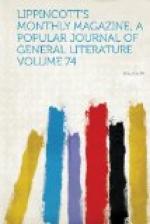In the long after years at Florence, Powers and I had many a laugh together over his reminiscences of the scenes that occurred in that exhibition-room, all of which he remembered as well as if the incidents had happened but a year before, and would chuckle over with as much enjoyment as he did at the time of their occurrence. My copy of the hand-bill which I have given above—doubtless the only one now in existence—was matter of much amusement to us, and served to recall every portion and every figure of the early work of his hands.
From the time I left America to go to Oxford, in the spring of 1829, till our meeting at Florence in 1841, I saw no more of Powers. But, as may be easily imagined, we lost no time in renewing our old friendship. He was then, and for many years afterward, living in the Via Romana, not far from the city gate of that name. The house stood back from the street, and was approached only by a passage through another tenement, from which it was divided by a little garden; a situation which, though not in all respects convenient, had at least the advantage of securing quietude. The young sculptor, with his already numerous and rapidly increasing family, occupied the first and second floors, while the ground floor was exclusively devoted to workshops and show-rooms. The premises were large and the accommodations ample. Already few Americans came to Florence without paying a visit to the “Studio Powers,” but they were in those days but few in comparison to the number which, partly as residents and partly as merely passing tourists, throng every winter the fair “City of Flowers.” Up to the revolution of 1848 the English at Florence were very far more numerous than the citizens of the other English-speaking nation. That unsuccessful movement drove many English, very unnecessarily, from their moorings. The English colony was very much reduced even after those who returned on the return of the grand duke had resumed their old places. And from that time forward I think that America has been more numerously represented on the banks of the Arno than England. Powers had at that time produced various successful busts, but had not as yet made himself known as an imaginative sculptor. Nevertheless, the former works had sufficed to give him an amount of reputation in the United States that ensured constant visits of his countrymen to the studio in the Via Romana.




